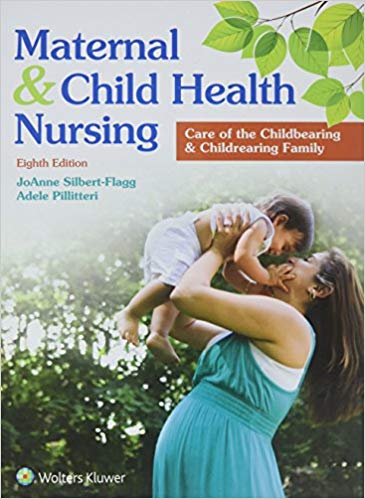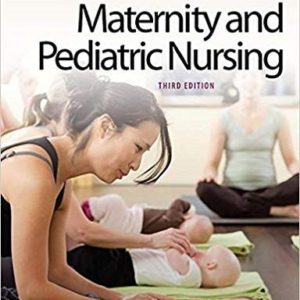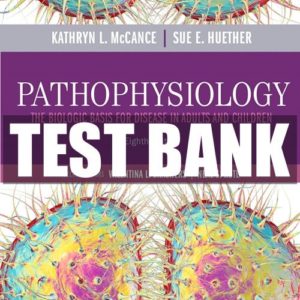Maternal & Child Health Nursing: Care of the Childbearing & Childrearing Family 8th Edition Test Bank
$25
Description
Maternal & Child Health Nursing: Care of the Childbearing & Childrearing Family 8th Edition Test Bank
You will receive this product immediate after placing the order
Table of Contents
1 A Framework for Maternal and Child Health Nursing
2 Diversity and Maternal Child Nursing
3 The Childbearing and Childrearing Family in the Community
4 Home Care and the Childbearing and Childrearing Family
5 The Nursing Role in Reproductive and Sexual Health
6 Nursing Care for the Family in Need of Reproductive Life Planning
7 Nursing Care of the Family Having Difficulty Conceiving a Child
8 The Nursing Role in Genetic Assessment and Counseling
9 Nursing Care During Normal Pregnancy and Care of the Developing Fetus
10 Nursing Care Related to Psychological and Physiologic Changes of Pregnancy
11 Nursing Care Related to Assessment of a Pregnant Family
12 Nursing Care to Promote Fetal and Maternal Health
13 The Nursing Role in Promoting Nutritional Health During Pregnancy
14 Preparing a Family for Childbirth and Parenting
15 Nursing Care of a Family During Labor and Birth
16 The Nursing Role in Providing Comfort During Labor and Birth
17 Nursing Care of a Postpartal Family
18 Nursing Care of a Family With a Newborn
19 Nutritional Needs of a Newborn
20 Nursing Care of a Family Experiencing a Pregnancy Complication From a Preexisting
21 Nursing Care of a Family Experiencing a Sudden Pregnancy Complication
22 Nursing Care of a Pregnant Family With Special Needs
23 Nursing Care of a Family Experiencing a Complication of Labor or Birth
24 Nursing Care of a Family During a Surgical Intervention for Birth
25 Nursing Care of a Family Experiencing a Postpartum Complication
26 Nursing Care of a Family With a High-Risk Newborn
27 Nursing Care of the Child Born With a Physical or Developmental Challenge
28 Principles of Growth and Development
29 Nursing Care of a Family With an Infant
30 Nursing Care of a Family With a Toddler
31 Nursing Care of a Family With a Preschool Child
32 Nursing Care of a Family With a School-Age Child
33 Nursing Care of a Family With an Adolescent
34 Child Health Assessment
35 Communication and Teaching With Children and Families
36 Nursing Care of a Family With an Ill Child
37 Nursing Care of a Family When a Child Needs Diagnostic or Therapeutic Modalities
38 Nursing Care of a Family When a Child Needs Medication Administration
39 Pain Management in Children
40 Nursing Care of a Family When a Child Has a Respiratory Disorder
41 Nursing Care of a Family When a Child Has a Cardiovascular Disorder
42 Nursing Care of a Family When a Child Has an Immune Disorder
43 Nursing Care of a Family When a Child Has an Infectious Disorder
44 Nursing Care of a Family When a Child Has a Hematologic Disorder
45 Nursing Care of a Family When a Child Has a Gastrointestinal Disorder
46 Nursing Care of a Family When a Child Has a Renal or Urinary Tract Disorder
47 Nursing Care of a Family When a Child Has a Reproductive Disorder
48 Nursing Care of a Family When a Child Has an Endocrine or a Metabolic Disorder
49 Nursing Care of a Family When a Child Has a Neurologic Disorder
50 Nursing Care of a Family When a Child Has a Vision or Hearing Disorder
51 Nursing Care of a Family When a Child Has a Musculoskeletal Disorder
52 Nursing Care of a Family When a Child Has an Unintentional Injury
53 Nursing Care of a Family When a Child Has a Malignancy
54 Nursing Care of a Family When a Child Has an Intellectual or Mental Health Disorder
55 Nursing Care of a Family in Crisis: Maltreatment and Violence in the Family
56 Nursing Care of a Family When a Child Has a Long-Term or Terminal Illness
Sample of test bank
1. For which reasons would a nurse review infant mortality statistics in the United States? (Select all that apply.)
A) Measures the quality of pregnancy care
B) Reviews information on overall nutrition
C) Compares health with those of other states
D) Determines infant health and available care
E) Provides an index of the country’s general health
Ans: A, B, D, E
Feedback:
Infant mortality statistics provide an index of a country’s general health, measures the quality of pregnancy care, provides information on overall nutrition, and determines infant health and available care. Infant mortality statistics compares the health with those of other countries and not with those of other states.
2. The nurse is providing care in an organization that supports the maternal and child care continuum. Which type of patient care area is an example of this approach?
A) Primary care
B) Team nursing
C) Case management
D) Family-centered care
Ans: D
Feedback:
Keeping the family at the center of care is important because the level of a family’s functioning is important to the health status of its members. A healthy family establishes an environment conducive to growth and health-promoting behaviors to sustain family members during crises. A family-centered approach enables nurses to better understand individuals and their effect on others and, in turn, to provide more holistic care. Primary nursing, team nursing, and case management do not necessary take into consideration the maternal and child care continuum.
3. Which actions should the nurse perform when supporting the goals of maternal and child health care? (Select all that apply.)
A) Advocates protecting the rights of the mother and fetus
B) Teaches family members interventions to improve health
C) Adheres to principles that focus on the needs of the mother
D) Encourages maternal hospitalization to regain strength and stamina
E) Assesses family members for strengths and specific needs or challenges
Ans: A, B, E
Feedback:
Actions that the nurse should perform when supporting the goals of maternal and child health care include advocating the rights for the mother and fetus, teaching health promotion interventions, and assessing the family for strengths and specific needs or challenges. Adhering to principles that focus on the needs of the mother and encouraging maternal hospitalization to regain strength and stamina are not actions that support the goals of maternal and child health care.
4. The nurse is reviewing the 2020 National Health Goals and notes that which is a focus of these goals?
A) Health promotion and disease prevention
B) Early diagnosis of chronic health problems
C) Effective use of medication to treat disease
D) Reduce the cost of health care and medications
Ans: A
Feedback:
The 2020 National Health Goals are intended to help citizens more easily understand the importance of health promotion and disease prevention and to encourage wide participation in improving health in the next decade. These goals do not focus on the early diagnosis of chronic problems, use of medications to treat disease, or reduce the cost of health care and medications.
5. The nurse has noticed a change in the type of care needed to support maternal and child health issues. What does the nurse realize as reasons for the changes in care? (Select all that apply.)
A) Smaller families
B) Less domestic violence
C) More employed mothers
D) Stable home environments
E) More single-parent families
Ans: A, C, E
Feedback:
Nursing care for maternal and child is changing because families are smaller, more mothers are employed out of the home, and there are more single-parent families. There is an increase in domestic violence, and families are less stable and more mobile, which influences homelessness.
6. During an assessment, the nurse asks a patient from a non-English-speaking culture which types of home remedies and herbs the patient uses for health care. What is the purpose of asking the patient this question?
A) Analyze for herb–drug interactions
B) Understand the patient’s philosophy of alternative health care
C) Determine the types of medications the patient will need to be prescribed
D) Explain to the physician the patient’s preference for nontraditional medicine
approaches
Ans: A
Feedback:
Assessing what alternative measures are being used is important because the action of an herb can interfere with prescribed medications. Assessing the use of herbal remedies is not done to understand the patient’s philosophy of alternative health care, determine the types of medications the patient will need to be prescribed, or explain the patient’s preferences for nontraditional medicine approaches to the physician.
7. The nurse notes that statistics on maternal mortality had improved but are again becoming elevated. What does the nurse realize as a reason for this change in maternal mortality rates?
A) Earlier prenatal care
B) Gestational hypertension
C) Increased vaginal deliveries
D) Treatment for chronic diseases
Ans: B
Feedback:
This increasing rate in maternal mortality is associated with more cesarean births, more gestational hypertension related to preexisting hypertensive disorders, and lack of health insurance for many Americans. This increase is not because of earlier prenatal care, increased vaginal deliveries, or treatment for chronic diseases.
8. A new mother asks the nurse if all of the new baby’s injections can be given in one visit because the mother is losing income from missing work because of the office visits. What does this new mother’s issue indicate to the nurse?
A) The mother needs to find an alternative employer.
B) The mother’s income is more important that the baby’s health.
C) Missing work does not support the baby’s health maintenance visits.
D) The federal government needs to do more to support well-baby visits.
Ans: C
Feedback:
An area that needs additional research is finding effective stimuli to encourage women to bring children for health maintenance visits. The mother losing income because of missing work for well baby visits will deter health maintenance visits for the baby going forward. This mother’s issue does not indicate that the mother needs to find another job, that the mother’s income is more important that the baby’s health, or that the federal government needs to do more to support well-baby visits.
9. The nurse works in a maternal and child care area that supports health promotion. Which activities will the nurse perform to support this philosophy of health care? (Select all that apply.)
A) Planning care
B) Patient teaching
C) Family counseling
D) New mother advocacy
E) Identifying nursing diagnoses
Ans: B, C, D
Feedback:
Extensive changes in the scope of maternal and child health nursing have occurred as health promotion has become a greater priority in care. The nursing activities for health promotion include teaching, counseling, and advocacy. Planning care and identifying nursing diagnoses are a part of the nursing process and not specific to health promotion.
10. During a care conference, a nurse provides everyone with a copy of the latest research on improving the success of breastfeeding for first-time mothers. Which Quality & Safety Education for Nurses competency does this nurse’s action support?
A) Quality improvement
B) Patient-centered care
C) Evidence-based practice
D) Teamwork and collaboration
Ans: C
Feedback:
Providing research material supports the Quality & Safety Education for Nurses competency of evidence-based practice because the nurse is integrating the best current evidence with clinical expertise and patient/family preferences and values for delivery of optimal health care. Providing research evidence does not support the Quality & Safety Education for Nurses competencies of quality improvement, patient-centered care, or teamwork and collaboration.
You must be logged in to post a review.




Reviews
There are no reviews yet.